Energy storage refers to the process of storing energy through a medium or device and releasing it when needed. Usually, energy storage mainly refers to electrical energy storage. Simply put, energy storage is to store electricity and use it when needed.
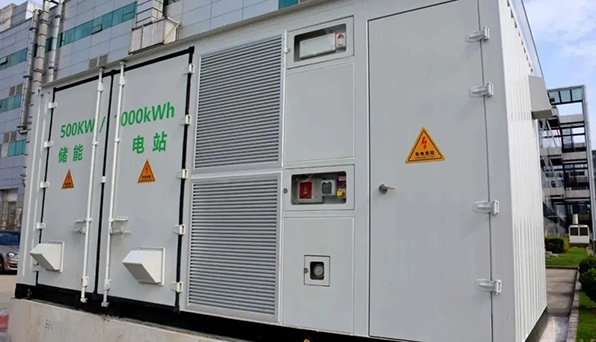
Energy storage involves a very wide range of fields. According to the form of energy involved in the energy storage process, energy storage technology can be divided into physical energy storage and chemical energy storage.
● Physical energy storage is the storage of energy through physical changes, which can be divided into gravity energy storage, elastic energy storage, kinetic energy storage, cold and heat storage, superconducting energy storage and supercapacitor energy storage. Among them, superconducting energy storage is the only technology that directly stores electric current.
● Chemical energy storage is the storage of energy in substances through chemical changes, including secondary battery energy storage, flow battery energy storage, hydrogen energy storage, compound energy storage, metal energy storage, etc. Electrochemical energy storage is the general term for battery energy storage.
The purpose of energy storage is to use the stored electric energy as a flexible regulating energy source, storing energy when the grid load is low, and outputting energy when the grid load is high, for peak-shaving and valley-filling of the grid.
An energy storage project is like a huge "power bank" that needs to be charged, stored, and supplied. From production to use, electric energy generally goes through these three steps: producing electricity (power plants, power stations) → transporting electricity (grid companies) → using electricity (homes, factories).
Energy storage can be established in the above three links, so correspondingly, the application scenarios of energy storage can be divided into: power generation side energy storage, grid side energy storage, and user side energy storage .
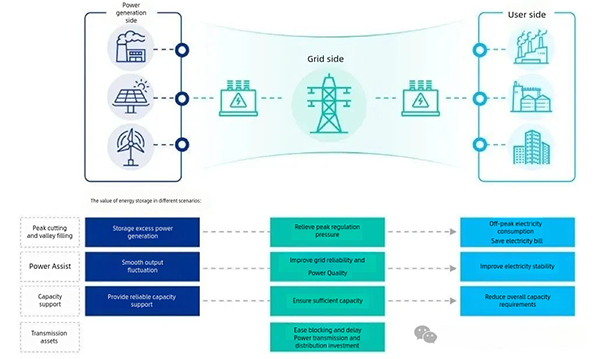
02
Three major application scenarios of energy storage
Energy storage on the power generation side
Energy storage on the power generation side can also be called energy storage on the power supply side or energy storage on the power supply side. It is mainly built in various thermal power plants, wind farms, and photovoltaic power stations. It is a supporting facility used by various types of power plants to promote the safe and stable operation of the power system. It mainly includes traditional energy storage based on pumped storage and new energy storage based on electrochemical energy storage, heat (cold) energy storage, compressed air energy storage, flywheel energy storage and hydrogen (ammonia) energy storage.
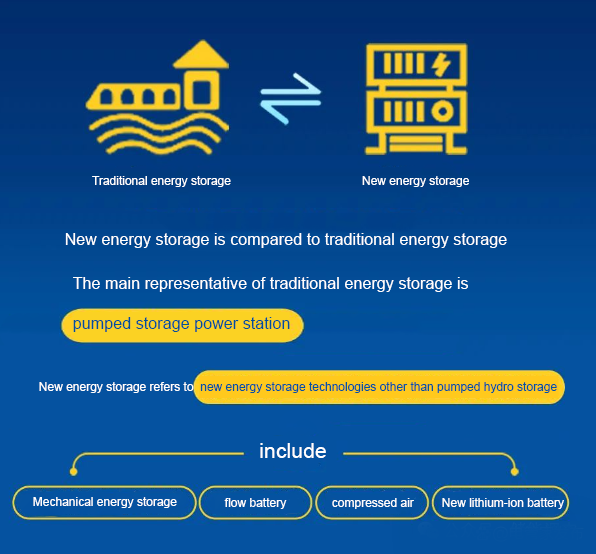
At present, there are two main types of energy storage on the power generation side in China.The first type is thermal power with energy storage. That is, through the method of thermal power + energy storage combined frequency regulation, the advantages of energy storage's rapid response are brought into play, the response speed of thermal power units is technically improved, and the response capacity of thermal power to the power system is improved. Thermal power distribution chemical energy storage has been widely used in China. Shanxi, Guangdong, Inner Mongolia, Hebei and other places have thermal power generation side combined frequency regulation projects.
The second category is new energy with energy storage. Compared with thermal power, wind power and photovoltaic power are very intermittent and volatile: the peak of photovoltaic power generation is concentrated in the daytime, and cannot directly match the peak of electricity demand in the evening and night; the peak of wind power generation is very unstable within a day, and there are seasonal differences; electrochemical energy storage, as a "stabilizer" of new energy, can smooth out fluctuations, which can not only improve the local energy consumption capacity, but also assist in the off-site consumption of new energy.
Grid-side energy storage
Grid-side energy storage refers to energy storage resources in the power system that can be uniformly dispatched by power dispatching agencies, respond to the flexibility needs of the power grid, and play a global and systematic role. Under this definition, the construction location of energy storage projects is not restricted and the investment and construction entities are diverse.
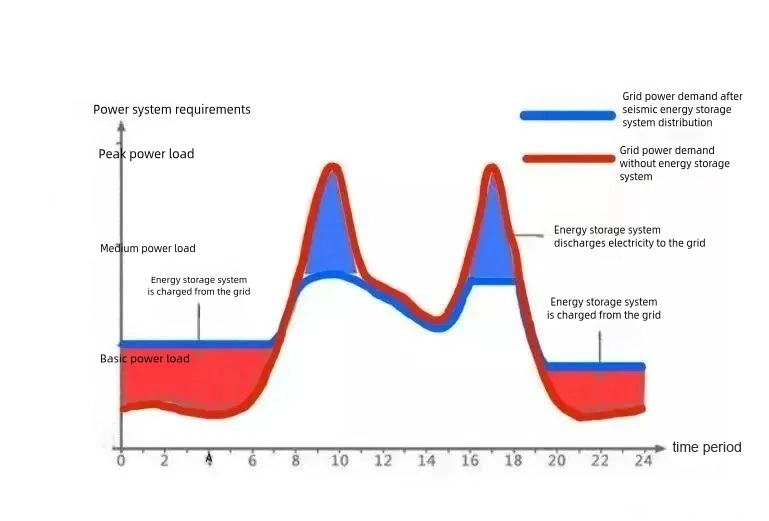
The applications mainly include power auxiliary services such as peak shaving, frequency regulation, backup power supply and innovative services such as independent energy storage. The service providers mainly include power generation companies, power grid companies, power users participating in market-based transactions, energy storage companies, etc. The purpose is to maintain the safety and stability of the power system and ensure the quality of electricity.
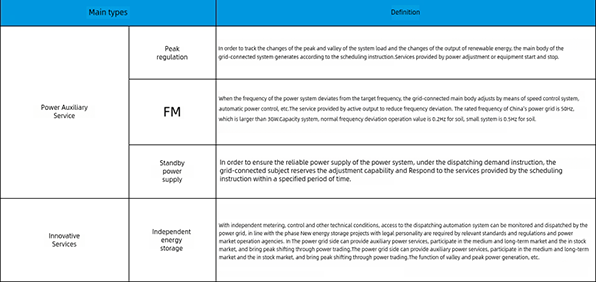
User-side energy storage
User-side energy storage usually refers to energy storage power stations built according to user demands in different user electricity usage scenarios with the purpose of reducing user electricity costs and reducing power outage and power restriction losses. The main profit model of industrial and commercial energy storage in China is peak-valley electricity price arbitrage. User-side energy storage can help householders save electricity costs by charging at night when the power grid is low and discharging during the day when electricity consumption is peak. The
National Development and Reform Commission issued the "Notice on Further Improving the Time-of-Use Electricity Price Mechanism", requiring that in places where the system peak-valley difference rate exceeds 40%, the peak-valley electricity price difference should not be less than 4:1 in principle, and in other places it should not be less than 3:1 in principle. The peak electricity price should not be less than 20% higher than the peak electricity price in principle. The widening of the peak-valley price difference has laid the foundation for the large-scale development of user-side energy storage.
03
The development prospects of energy storage technology
In general, the development of energy storage technology and the large-scale application of energy storage devices can not only better guarantee people's electricity demand and ensure the safe and stable operation of the power grid, but also greatly increase the proportion of renewable energy power generation, reduce carbon emissions, and contribute to the realization of "carbon peak and carbon neutrality".
However, since some energy storage technologies are still in their infancy and some applications are not yet mature, there is still a lot of room for development in the entire energy storage technology field. At this stage, the problems faced by energy storage technology mainly include these two parts:
1) The development bottleneck of energy storage batteries : environmental protection, high efficiency, and low cost. How to develop environmentally friendly, high-performance, and low-cost batteries is an important topic in the field of energy storage research and development. Only by organically combining these three points can we move towards marketization faster and better.
2) The coordinated development of different energy storage technologies : Each energy storage technology has its own advantages and disadvantages, and each technology has its own special field. In view of some practical problems at this stage, if different energy storage technologies can be used together organically, the effect of leveraging strengths and avoiding weaknesses can be achieved, and twice the result with half the effort can be achieved. This will also become a key research direction in the field of energy storage.
As the core support for the development of new energy, energy storage is the core technology for energy conversion and buffering, peak regulation and efficiency improvement, transmission and scheduling, management and application. It runs through all aspects of new energy development and utilization. Therefore, the innovation and development of new energy storage technologies will pave the way for future energy transformation.
Join Amensolar ESS, the trusted leader in home energy storage with 12 years of dedication, and expand your business with our proven solutions.
Post time: Apr-30-2024








